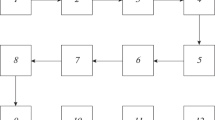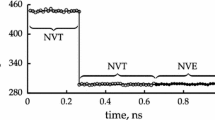Abstract—
An idea proposed by us previously is used in this paper. The idea is that the first coordination number in the structure of an amorphous substance is independent of the amplitudes of atomic thermal vibrations near the equilibrium position. A corresponding algorithm is developed, and a program which makes it possible to calculate the radial distribution function (RDF) of atoms in the automatic mode is created. The program calculates the normalization coefficient of the interference function and subtracts the incoherent scattering background. The program and algorithms are tested and debugged using the electron diffraction analysis of well-studied amorphous-Ge thin films. Tungsten-trioxide thin films obtained by pyrolysis are used as the substance under study. The results of RDF construction showed that it is necessary to correct the atomic WO3 model. Experimental curves for the intensities of both substances are obtained using our developed precision system for measuring electron diffraction patterns using an EMR-102 electron diffractometer. The developed algorithms and computing methods are independent of the type of radiation (diffraction of electrons, neutrons or X-rays) and make possible calculation of the first coordination number with an accuracy of several percent.



Similar content being viewed by others
REFERENCES
B. E. Warren, Phys. Rev. B 45, 657 (1934).
T. Egami and S. J. L. Billinge, Underneath the Bragg Peaks: Structural Analysis of Complex Materials (Pergamon, New York, 2003).
V. Petkov, Mater. Today, No. 11, 28 (2008).
B. K. Vainshtein, Kristallografiya 2 (1), 29 (1957).
I. D. Nabitovich, Ya. I. Stetsiv, and Ya. V. Voloshchuk, Kristallografiya 12 (3), 584 (1967).
L. I. Tatarinova, Electron Diffraction of Amorphous Materials (Nauka, Moscow, 1972) [in Russian].
Ya. I. Stetsiv, Kristallografiya 8 (2), 257 (1973).
A. F. Skryshevskii, Structural Analysis of Liquids and Amorphous Solids (Vysshaya Shkola, Moscow, 1980) [in Russian].
X. J. Kliava, Phys. C: Solid State Phys. 15, 7017 (1982).
S. J. Gurman, J. Mater. Sci. 17, 1541 (1982).
V. P. Zakharov and V. S. Gerasimenko, Structural Features of Semiconductors in Amorphous State (Naukova Dumka, Kiev, 1976) [in Russian].
O. I. Vasin, G. I. Gladysheva, and E. I. Dagman, Kristallografiya 28 (3), 446 (1983).
R. W. James, The Optical Principles of the Diffraction of X-Rays (G. Bell and Sons, London, 1948; Inostrannaya Literatura, Moscow, 1950).
A. K. Kulygin, K. V. Kulygin, and A. S. Avilov, Crystallogr. Rep. 65, 324 (2020).
A. K. Kulygin, K. V. Kulygin, and A. S. Avilov, in Proc. 12th Annual Meeting of the RAS Scientific Council on Condensed Matter Physics and the Scientific-Practical seminar “Current Problems of Condensed Matter Physics” (Chernogolovka, 29–30 October2019), p. 63.
S. S. Olevskii, M. S. Sergeev, A. L. Tolstikhina, et al., Dokl. Akad. Nauk SSSR, 275 (6), 1415 (1984).
ACKNOWLEDGMENTS
We are grateful to A.L. Tolstikhina for the preparation of tungsten-trioxide samples and for placing them at our disposal.
Funding
The work was supported by the Ministry of Science and Higher Education within the framework of the State Assignment of the Federal Scientific Research Center “Crystallography and Photonics” of the Russian Academy of Sciences with the use of equipment of the Center of Collective Use of the Federal Scientific Research Center “Crystallography and Photonics” and was also supported by the Ministry of Education and Science (project RFMEFI62119X0035).
Author information
Authors and Affiliations
Corresponding authors
Additional information
Translated by L. Kulman
Rights and permissions
About this article
Cite this article
Vasin, O.I., Novikova, V.V., Kulygin, A.K. et al. Automation of the Method for Construction of the Radial Distribution Function for Studying the Structure of Amorphous Substances. J. Surf. Investig. 14, 1085–1091 (2020). https://doi.org/10.1134/S1027451020050201
Received:
Revised:
Accepted:
Published:
Issue Date:
DOI: https://doi.org/10.1134/S1027451020050201




